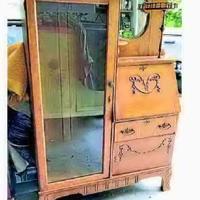Hello: Following the passing of my 95-year-old grandmother, we are now sorting through her possessions and seeking your expertise. Among her belongings is a secretary hutch/desk measuring 70 by 13 by 38 inches. Can you provide any insights?
Dear L.C.: These items are sometimes referred to as “side-by-sides” or Larkin desks.
John D. Larkin, the founder of the Larkin Soap Co. in Buffalo, New York in 1875, is the reason for the latter term. Initially, the company’s main product was called Sweet Home soap.
Larkin received assistance from Elbert Hubbard, his first salesman and brother-in-law, who later became the author of the essay “A Message to Garcia” and one of the pioneers of the American arts and crafts movement. Hubbard suggested adding a “premium” to Larkin’s soap.
People are also reading…
Initially, these premiums were simply cards featuring the company logo, but soon evolved into colorful pictures that housewives could exchange. The concept grew to include a free handkerchief with Pure White soap and a free bath towel with Ocean Bath soap.
Large wholesale orders eventually included piano lamps, Morris chairs, or oak dining-room chairs.
The business flourished to the point where Larkin dismissed all salesmen and intermediaries and transitioned to mail order. The company produced a catalog (which would later become second only to Sears’) that featured available premiums. Due to the success, Larkin set up a furniture manufacturing factory in Buffalo, which assembled parts cut in Tennessee. Buffalo Pottery was established for pottery production, while glass, silver-plated wares, and men’s clothing were sourced from various suppliers.
Although side-by-side desks were popular Larkin products, it is challenging to confirm that this specific piece was made by Larkin without an attached label, as many other furniture companies produced similar items.
Regardless, side-by-side units with a desk, bookcase, and mirror often bear the Larkin name, whether or not the soap company actually manufactured them.
Most likely produced between 1900 and 1910, this piece remains a practical household item.
However, collectors’ interest in these units has significantly waned over the past few decades. Previously, a beautiful golden oak side-by-side desk/bookcase like this could fetch up to $800 at auction.
Regrettably, as of 2005, the value has plummeted. Similar units now sell at auctions for $175 to $300, a figure we consider undervalued and likely to rise in the near future.
This article was originally published on October 7, 2019.





